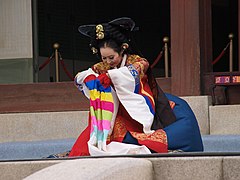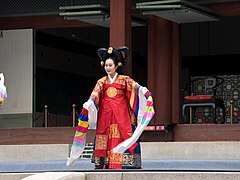|
Taepyeongmu
Taepyeongmu (Korean: 태평무; lit. great peace dance) is a Korean dance with the function of wishing a great peace for the country. Its exact origin is unknown, but certain style of the present was composed by Hahn Seongjun (Korean: 한성준; Hanja: 韓成俊; 1874–1941), an outstanding master of Korean dance in the beginning of last century. There are three assumptions regarding the origin of Taepyeongmu. One is a court dance occasionally performed by kings during the Joseon dynasty. Therefore, the costumes used by the dancers are similar to the gwanbok (hangul: 관복; literally "official clothing") formerly worn by Korea's kings and queens.[1] Taepyeongmu reflects the aesthetic principle of inner dynamics in the stillness, which is the essence of Korean traditional dance. [1] Taepyeongmu is designated as one of the Important Intangible Cultural Properties of South Korea. Famous practitioners have included Han Young-suk, designated a Living National Treasure for her performances.[2] See alsoWikimedia Commons has media related to Taepyeongmu. References
External links
|
||||||||||||||













